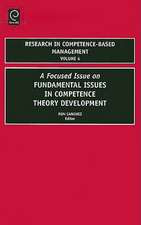Being There Even When You are Not – Leading Through Strategy, Structures, and Systems
Autor Robert Hooijberg, J.g. Hunt, John Antonakis, Kimberly B. Boal, Nancy Laneen Limba Engleză Hardback – 25 iun 2007
The six major sections in this book coincide with these aspects of the leader’s architectural focus. The first chapter in each section provides a short theoretical introduction. Following the theory chapters are application chapters, highlighting the practical implications of the theory with real-life examples. The sixth section explores the relationship between complexity theory and strategic leadership.
*Examines indirect leadership - the leadership OF organizations
*Explores how leaders exercise leadership indirectly through structures, processes and systems that stimulate others to contribute to organizational goals
*Contains six major sections: leadership development, knowledge management, influencing and shaping meaning, leader discretion, vision cascading, and complexity theory and the networked organization
Preț: 1169.32 lei
Preț vechi: 1518.60 lei
-23% Nou
Puncte Express: 1754
Preț estimativ în valută:
223.75€ • 234.20$ • 186.23£
223.75€ • 234.20$ • 186.23£
Carte tipărită la comandă
Livrare economică 31 martie-14 aprilie
Preluare comenzi: 021 569.72.76
Specificații
ISBN-13: 9780762313327
ISBN-10: 0762313323
Pagini: 334
Dimensiuni: 168 x 214 x 25 mm
Greutate: 0.64 kg
Ediția:New.
Editura: Emerald Publishing
ISBN-10: 0762313323
Pagini: 334
Dimensiuni: 168 x 214 x 25 mm
Greutate: 0.64 kg
Ediția:New.
Editura: Emerald Publishing
Public țintă
Researchers, students and practitioners interested in management, leadership development, and network organizational theory.Cuprins
Contents
Introduction Leadership of and in organizations
Part 1: Developing leadership capacity
Part 2: Knowledge management
Part 3: Managing meaning
Part 4: Leadership discretion
Part 5: Cascading leadership
Part 6: Leadership in complex environments
Concluding Thoughts
Introduction Leadership of and in organizations
Part 1: Developing leadership capacity
Part 2: Knowledge management
Part 3: Managing meaning
Part 4: Leadership discretion
Part 5: Cascading leadership
Part 6: Leadership in complex environments
Concluding Thoughts















